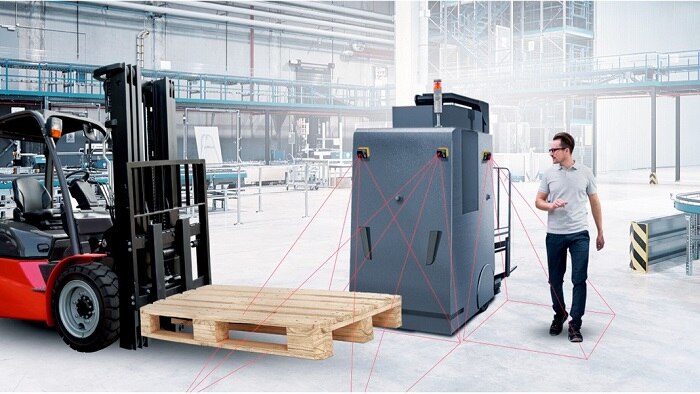Although no specific data is available on forklift accidents, the statistics give us an insight into the importance of safety on the factory floor. Eurostat data shows that in 2020, non-fatal accidents in the manufacturing sector accounted for 18.6% of all accidents in the EU, while fatal accidents accounted for 15.2% of the total.
Automation technologies can help companies improve the safety of employees when they are working in environments where forklifts operate. Sensors, for example, are able to support operators with solutions that ensure high safety of movement, precise positioning, and position recognition.
H2: Forklift safety: Backup Assistance System
An example of a forklift safety system is the
SICK Backup Assistance System (BAS), which generates alerts when a vehicle is in close proximity to a person or object to help drivers avoid accidents. This is especially important in cases of reduced vision, such as blind spots or during reversing manoeuvres. BAS is a stand-alone system that doesn't require reflectors or transmitters and is an ideal solution for ensuring targeted coverage of known blind spots as well as optimising the coverage of the side areas, where the driver's view is reduced.
The
Backup Assistance System provides a
warning signal when an obstacle is detected. The system comprises one or more
TiM351 LiDAR sensors, a control unit, a light bar, and an audible alarm.
The LIDARs can be installed on the rear of the forklift or attached to the side of the vehicle to increase visibility. The area to be monitored can be scaled and easily adjusted. The Backup Assistance System is also characterised by low power consumption, which minimises the vehicle's battery consumption.
H2: Forklift safety: Drive Assist System
The
SICK Drive Assist System (DAS) is a collision avoidance system for forklift safety. It can be integrated directly by the vehicle manufacturer into the control unit, and it is also possible to implement a customizable warning function or dialogue directly with the vehicle control unit. In this way it is possible, for example, to reduce the vehicle's speed or stop it.
The system allows the implementation of integrated warning strategies for anti-collision function and driver support. The detection of the environment is 270 degrees and can be specifically adapted to the use of the vehicle. Distances between vehicles and objects can be determined precisely for the protected area thanks to the sensor output which provides distance values in polar coordinate from predefined sectors.
Object detection is reliable and independent of shape or surface, even in environments with intense ambient light. Smart data pre-processing takes place directly on the sensor, thus avoiding the need for additional hardware or software.
H2: Forklift safety: solutions for pick and place applications
Forklift safety is not only relevant for movement inside or outside the factory.
Pick and place operations can also pose a danger to operators. SICK's
inductive proximity sensors from the
IME and
IMB series enable the precise detection of fork positions so that information can be presented to the operator conveniently on a display.
Finally, to allow
fork height measurement and detection of lateral movements the SICK linear encoder
EcoLine can be integrated into the lifting frame. This enables automatic pre-adjustment with different pallet sizes.


